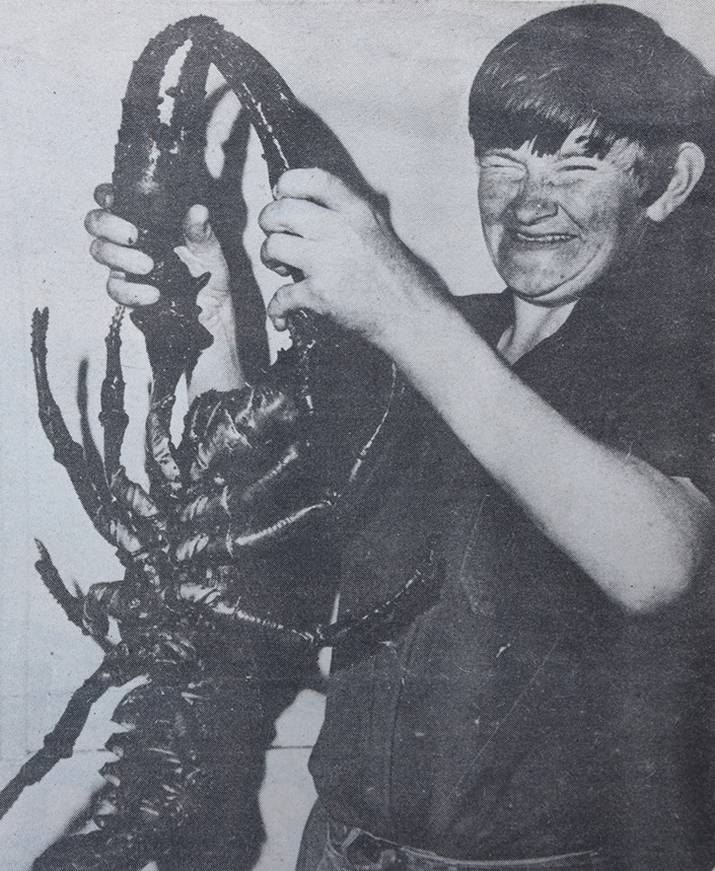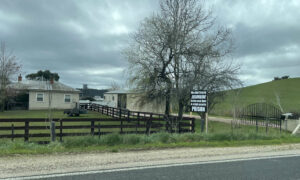*Pic: A 4.5 kg freshwater Crayfish caught in the Flowerdale River around 1985. – Photo credit unknown
Tayatea the world’s largest crayfish lives on, but not as it did before European settlement. For the Tayatea, the Tarkine and the adjacent northern rivers are the strongholds for its future survival, and only full protection of its habitat in a permanent secure reserve can ensure this.
Old bushman tales claim that there were giant ones that grew over 6 kilograms. These for all we know, could have lived to be a century old. Prior to mass forest clearance and habitat disturbance it was said that people came back from fishing trips with potato bags full that were caught within an hour, claiming to throw anything back in the water that was smaller than 2 kilograms.
Often mislabeled as a Lobster, the Giant Freshwater Crayfish, Asticopsis gouldi, is the largest and the slowest growing of the 3 Tasmanian endemics. The Tayatea are restricted to the rivers that flow into Bass Strait and the Arthur River.
One legendary tale on Lobsters – https://www.youtube.com/watch?v=SCoZWkqOjBA
The giant Crayfish was first officially identified by renowned naturalist James Gould in 1870, though its existence was well know long before then, and settlers to the northwest of the state where said to be eating them back in 1829.
The Tasmanian Aboriginals probably feasted on these when they travelled inland as they would have been abundant in the undisturbed catchments of all the rivers, though in this 21st century there are very few remote creeks and rivers where they haven’t been fished to some degree.
It is alleged that the Tayatea was introduced to some streams in the east and the southeast of Tasmania, but failed to survive.
Crayfish expert Todd Walsh with a recent discovery of a one-clawed Tayatea in Northwest Tasmania
Lake Chisholm in the Tarkine. – Access to this region was opened up through forestry activity over half a century ago. The Forestry Commission did place a sign onsite prohibiting the removal of the crayfish, which had an opposite effect as the sign, and probably all the big crayfish were then soon pilfered. The current crayfish population in the lake is unknown
Distribution of Asticopsis gouldi
The Tayatea habitat at Lapoinya – https://www.youtube.com/watch?v=VUi4I0kv3zo
Further reading on the conservation of the species
https://en.wikipedia.org/wiki/Tasmanian_giant_freshwater_crayfish
http://oldtt.pixelkey.biz/index.php?/article/recovery-plan-fails-the-freshwater-lobster/
http://oldtt.pixelkey.biz/index.php?/pr-article/ws-congratulates-environment-ministers-on-plan-to-save-wo/
http://oldtt.pixelkey.biz/index.php?/article/unless-…the-giant-freshwater-lobster-will-disapp/
*Ted Mead remembers in his early teen years seeing an abundance of freshwater crayfish in the country streams where he grew up, though he suspects their existence ceases to be today due to pollution, siltation, storm water run-off, and the abundance of pesticides and superphosphates laid across the farming landscape.






























john hayward
April 16, 2018 at 23:28
Don’t hold your breath. The GFC was only protected in Tasmania about twenty years ago after locals pointed out it was already on federal endangered species lists, and threatened legal action to take it off Tas fishing licenses.
Forestry Tas, whose 8 year objection to the protection of the Cray’s breeding streams from logging, and exemption to Federal environmental law, has greatly contributed to their decline. The herbicides they use with abandon, on top of post-logging siltation, are lethal to crustacean breeding.
John Hayward